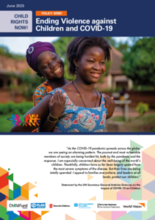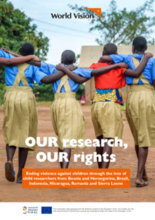Displaying 131 - 140 of 1050
The aim of the present study was to systematically review and evaluate the measurement of self-reported polyvictimization with foster youth samples.
Ce webinaire lance une note technique, COVID-19 et la protection des enfants contre la violence, les abus et la négligence à domicile.
This article describes the first United States-based national study to compare the rates of substantiation of maltreatment among cases reported to child protective services involving caregivers with and without disabilities.
This study extends our understanding of use of failure to protect (FTP), a sub-type of neglect, by examining who workers substantiate for FTP, in what context, and the justifications they use.
In this policy brief, Joining Forces, as a coalition of six child rights organisations, calls for child protection to be prioritised in the response to COVID-19.
The vision of the National Prevention and Response Plan is to foster a society where all children live free of all forms of violence. Its goal is for all children in Kenya to be protected from physical, sexual and emotional violence, and for those children who experience violence to have access to care, support and services. It aims to reduce the prevalence of childhood violence – that is, a child experiencing at least one form of physical, emotional and sexual violence – by 40 per cent by 2024.
This child-led research initiative was conducted under the umbrella of World Vision’s DEAR project (Development Education and Awareness Raising) and the Sustainable Development Agenda 2030. The study explores explore SDG 16.2, the goal that focuses on the issue of ‘abuse, exploitation, trafficking, and all forms of violence against and torture of children’.
This study uses secondary data analysis of the Canadian Incidence Study of Reported Child Abuse and Neglect 2008 to explore what case and worker factors predict the provision of ongoing child welfare services.
In this study, a transdisciplinary group of key stakeholders in Australia jointly constructed a causal loop diagram to bring forth the systemic structure underlying the issue of repeat child removals (where parents lose successive infants and children to out-of-home care) and identify system conditions that need to be altered.
This article illuminates the important role the Committee on the Rights of the Child played in monitoring child abuse and neglect in the implementation of the now thirty years old Convention on the Rights of the Child (CRC).



